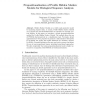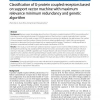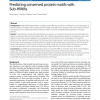12 search results - page 2 / 3 » Protein Family Classification Using Sparse Markov Transducer... |
BMCBI
2004
13 years 7 months ago
2004
Background: Hidden Markov Models (HMMs) have proven very useful in computational biology for such applications as sequence pattern matching, gene-finding, and structure prediction...
BMCBI
2004
13 years 7 months ago
2004
Background: G protein-coupled receptors (GPCRs) transduce signals from extracellular space into the cell, through their interaction with G proteins, which act as switches forming ...
AUSAI
2008
Springer
13 years 9 months ago
2008
Springer
Hidden Markov Models are a widely used generative model for analysing sequence data. A variant, Profile Hidden Markov Models are a special case used in Bioinformatics to represent,...
BMCBI
2010
13 years 7 months ago
2010
Background: Because a priori knowledge about function of G protein-coupled receptors (GPCRs) can provide useful information to pharmaceutical research, the determination of their ...
BMCBI
2010
13 years 2 months ago
2010
Background: Profile HMMs (hidden Markov models) provide effective methods for modeling the conserved regions of protein families. A limitation of the resulting domain models is th...



